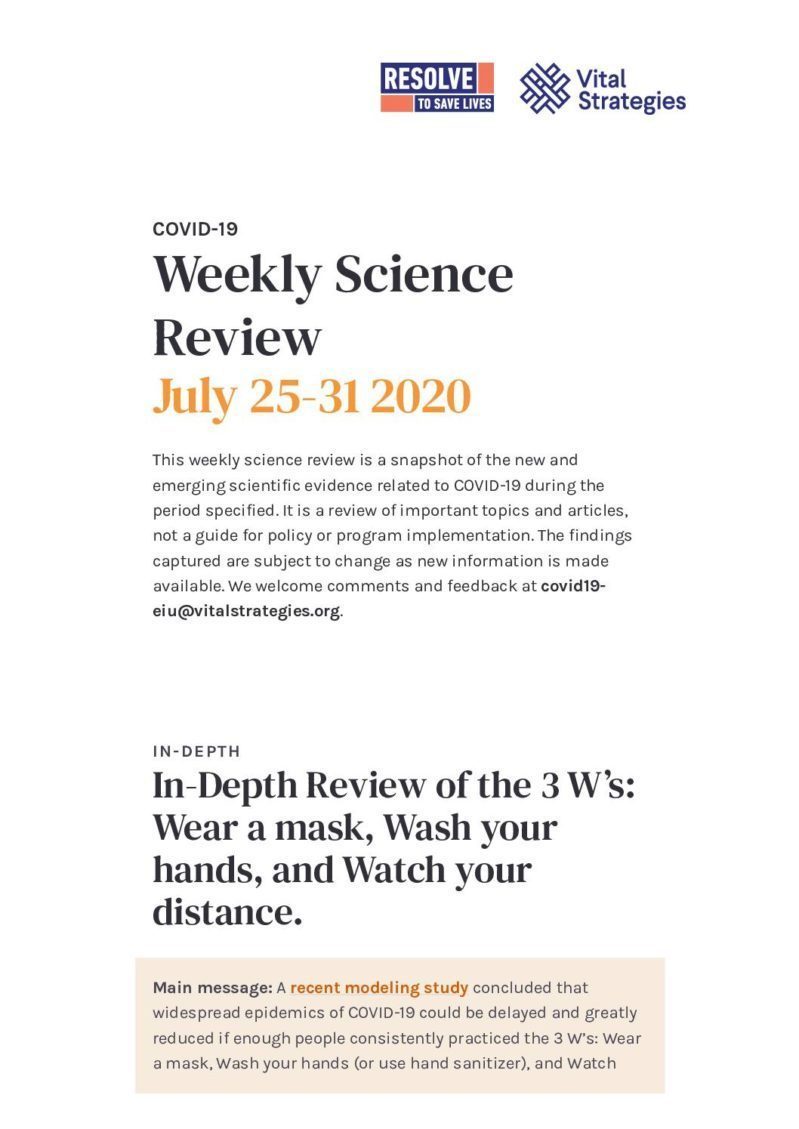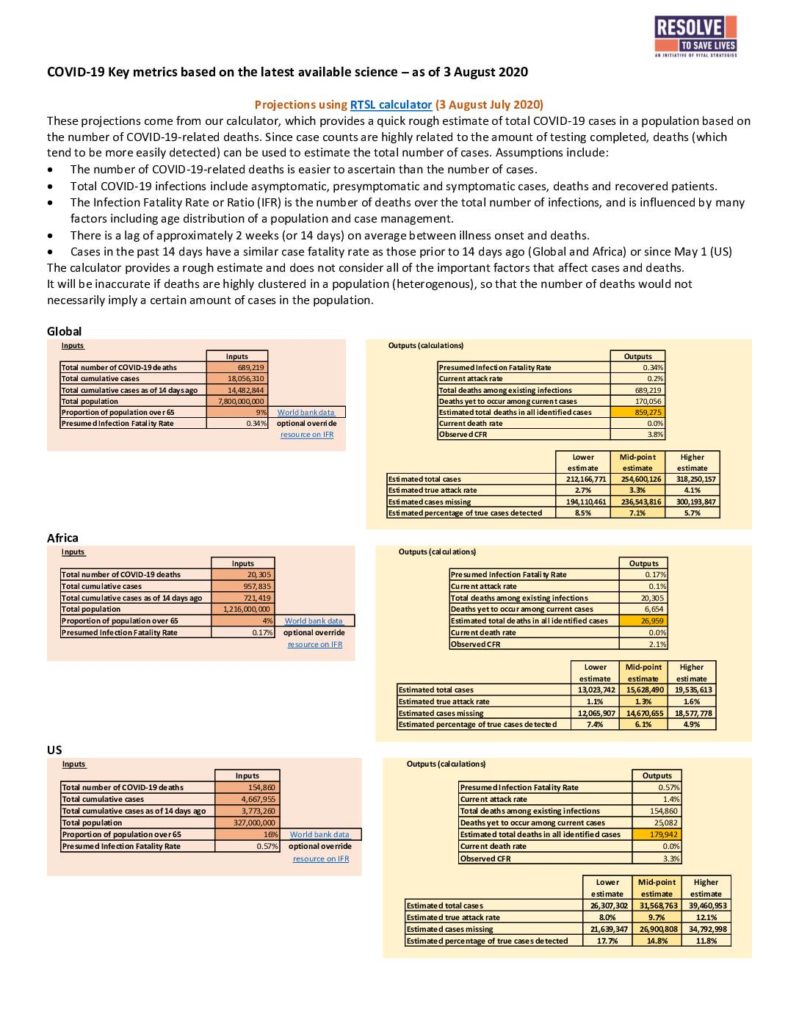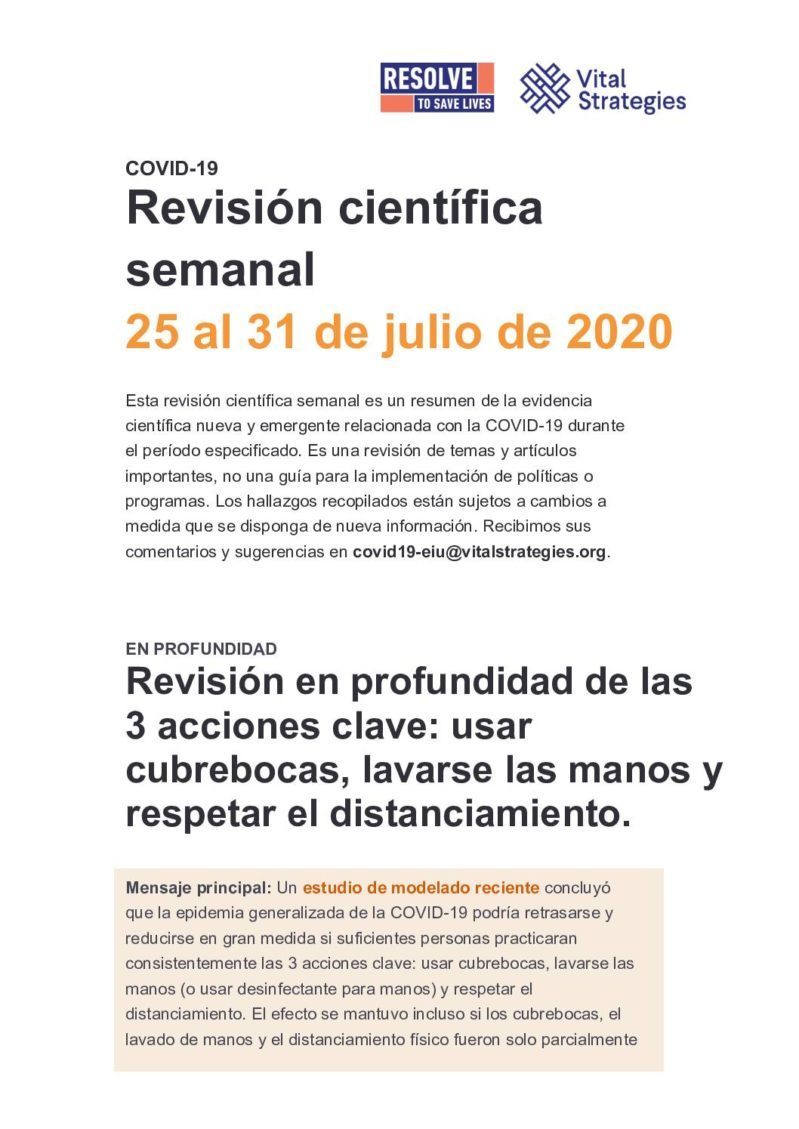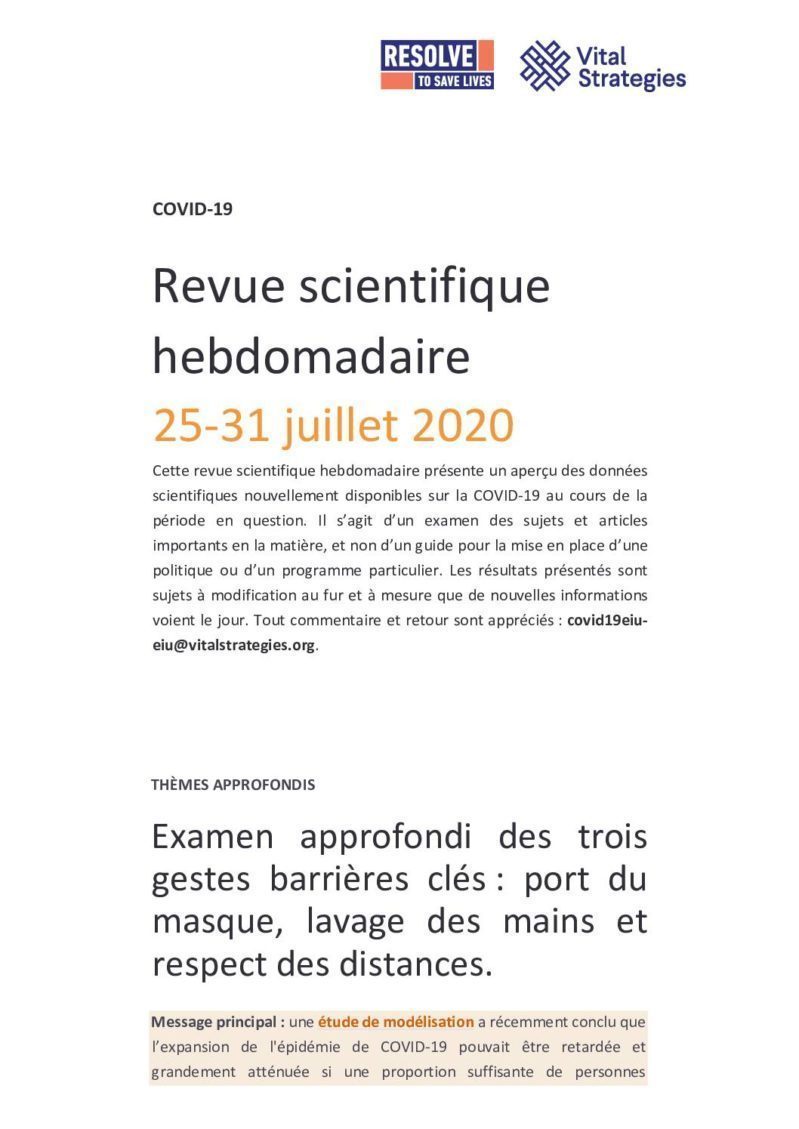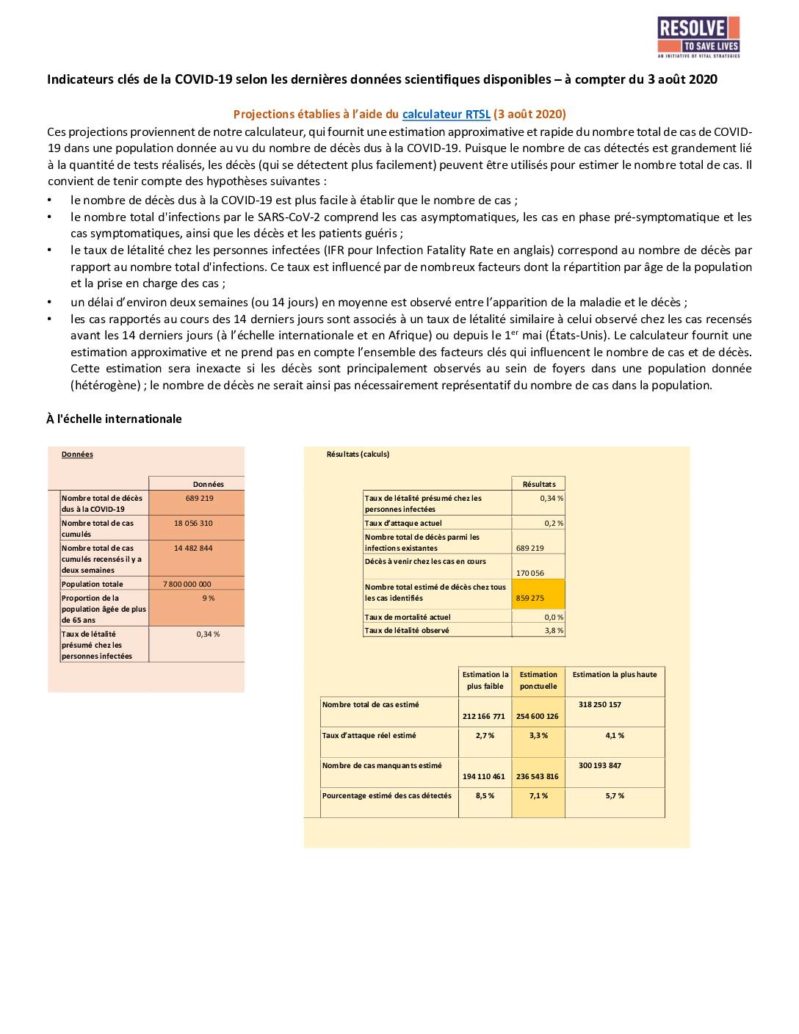In-depth
In-Depth Review of the 3 W’s: Wear a mask, Wash your hands, and Watch your distance.
Wear a mask
In some locations, face masks remain contentious in the fight against COVID-19, even as their use becomes more widely recommended and even mandated by global, national and local authorities, educational systems, corporations, and individual enterprises. In previous Weekly Science Reviews we have featured updates on the primary importance of respiratory transmission of SARS-CoV-2, the virus that causes COVID-19, and the evolution of public health recommendations for masks and face coverings. In health care settings, there is evidence based on randomized controlled trials that medical procedure masks (also called surgical masks) and respirators can prevent respiratory infections (including coronaviruses) in health workers. For the general public, however, this same kind of evidence is not available. There haven’t been experimental trials of general face mask use specifically for COVID-19, and those that have been done for other respiratory infections are not conclusive. Even so, observational studies that compare settings where public face mask use is common to others where it is not—sometimes called “natural experiments”—suggest that community mask use could reduce respiratory infections including the coronaviruses that cause SARS, MERS and COVID-19. In addition, many laboratory and engineering studies demonstrate convincingly that face coverings can block large respiratory droplets and reduce the velocity of smaller particles, which could reduce transmission risk. Finally, mathematical modeling studies have been helpful for considering how widespread community mask use and other strategies can affect the course of a local outbreak or national epidemic, even while experience and evidence accumulate.
Recommendations on the use of face coverings by the general population exemplify this dynamic as we learn more about COVID-19. Both the World Health Organization (WHO) and the U.S. Centers for Disease Control and Prevention (CDC) have adopted guidance for face mask use by the general public in settings with community transmission. Medical procedure masks and respirators should generally be prioritized for health care workers, patients with known or expected COVID-19 illness, and those caring for them at home. Local guidance varies from place to place, but cloth masks and other face coverings are increasingly recommended or required when people are in public outside of their home setting, especially in indoor settings and where physical distancing is difficult. Masks can protect the general public in two ways. When worn by someone who may be infectious, they can reduce and slow particles that may propel the virus toward another person. When that person is also wearing a face covering, the barrier may provide additional protection. Even masks that are only partially effective can substantially reduce the risk of transmission, especially when enough people use them and when they are combined with other effective public health and social measures.
Wash your hands
Washing hands with soap and water or using alcohol-based hand sanitizer when water is not available is a basic and common sense way to both protect yourself and reduce spread of COVID-19. People’s hands can spread infection after they touch something contaminated with viruses including SARS-CoV-2, the virus that causes COVID-19. Hands can pick up infectious organisms from the environment and other people in many ways. Washing hands can reduce infection, both in the person who washes hands, and in others who they touch or who touch objects they have touched.
Transmission of bacteria and viruses from contaminated hands has been studied extensively in the health care setting, and the role of contaminated hands in transmitting disease is well established. There is real-life evidence, as well as data from research studies and models that have shown how significantly hand-washing can reduce transmission of infections, especially for respiratory and diarrheal diseases. The reason is that hand-washing can kill or inactivate the organisms that cause disease. The U.S. CDC has a website dedicated to the science behind hand-washing, where it summarizes evidence for the best technique, duration and moments for hand-washing.
There are times when hand-washing is most important. CDC states that for COVID-19 specifically, people should wash their hands after being out in public, after coughing, sneezing or blowing their nose and before and after caring for someone who is sick. People should always wash their hands if they are potentially contaminated before touching their eyes, nose and mouth, including when removing or replacing face masks, as contact with these areas is one way germs enter the body and make us sick. People should also wash their hands before and after eating, before, during and after food preparations, after using the bathroom or changing a diaper, after handling an animal or pet and after touching or handling garbage.
Most of the time, using soap and water to wash hands for 20 seconds followed by drying with a clean towel or air is the best way to keep hands clean. However, when soap and water are not readily available, alcohol-based hand sanitizers that contain a minimum of 60% alcohol serve as a good substitute.
Watch your distance
Keeping physical space between people reduces the spread of respiratory viruses such as SARS-CoV-2. Transmission of respiratory viruses occurs mainly between people who are close to one another for a prolonged period of time, as this increases the chance that live viral particles exhaled by the infected person may land in another person’s mouth, nose or eyes, or be inhaled into their lungs. For COVID-19, physical distancing is especially important because people are most infectious before and in the early stages of when they feel ill (see article reviewed below), even before symptoms are apparent, and a significant proportion of people infected with SARS-CoV-2 never develop symptoms, so disease may be spread by people who do not know they are infectious. CDC recommends that people who are not from the same household keep at least 6 feet of physical distance between each other. WHO recommends physical distancing of at least 3 feet. The length of distancing endorsed by public health entities varies between countries. It can be difficult to implement longer physical distances in public indoor environments, which has contributed to debates about whether there is enough scientific evidence to support specific distance recommendations.
It can be difficult to assess the extent to which physical distancing reduces the transmission of respiratory viruses in the community, in part due to the challenges of using observational studies (“natural experiments”) to accurately assess the impact of physical distancing. A recent systematic review and meta-analysis on the extent to which face masks, eye protection and physical distancing reduce SARS-CoV-2 transmission in and outside health care settings found that physical distancing of at least 3 feet is associated with a 70% reduction in SARS-CoV-2 infections, and that distances of at least 6 feet might be even more effective in reducing transmission. In reality, there is no firm border between safe and unsafe; longer distances are safer, and 6 feet is likely safer than 3 feet. The degree of protection afforded by a physical distance is determined largely by the mechanisms through which the virus may travel between people. We recently reviewed evidence about whether there may be airborne transmission of SARS-CoV-2 in light of an open letter to the WHO arguing that evidence of airborne transmission warrants revision of public health recommendations. Under the distinction between airborne transmission versus droplet transmission, viruses are thought to travel either longer distances (if they are airborne) or shorter distances (if they are transmitted via droplets). Although there is evidence that exhalations generate turbulent gas clouds that carry particles across a continuum of sizes and that the dichotomy between airborne and droplet transmission is over-stated, physical distancing rules imply that the dominant route of SARS-CoV-2 is via droplets that do not travel far. Challenging this are studies that suggest droplets may travel farther than 6 feet, and evidence from COVID-19 outbreaks suggests that some degree of airborne transmission cannot be ruled out. To complicate matters, there are several factors that influence the risk of transmission across distances, including the type of exhalation (speaking, singing, coughing or sneezing) and environmental conditions (indoor versus outdoor) and ventilation. It is likely that numerical distance thresholds for physical distancing oversimplify complex transmission processes and that specific characteristics of each setting significantly influence transmission risk. That said, given the impossibility of assessing transmission risk in real time in every possible encounter, it remains advisable that physical distancing of at least 6 feet be observed whenever possible. WHO advises avoidance of three types of settings in which there may be increased risk of transmission: crowded areas, places in which there may be close contact between people, and confined spaces. Those are settings in which physical distancing may be difficult and other factors (i.e., lack of ventilation) may further increase the risk of transmission.
FAQs
Should the general public wear eye protection to protect from COVID-19?
The general public likely would not benefit substantially from eye protection for everyday, low-risk activities. Eye protection, usually glasses, goggles or a clear plastic face shield, is a standard part of personal protective equipment (PPE) for health care workers caring for patients with COVID-19. A recent review article in the Lancet found that wearing eye protection could reduce by up to 66% the risk of coronavirus (SARS, MERS or COVID-19) transmission to health care workers caring for infected patients. For health care workers or others engaged in activities that require contact with people likely to be infected, eye protection may reduce transmission.
Although some scientists have proposed that face shields could be worn by the general public instead of face masks, the CDC “does not recommend use of face shields for normal everyday activities or as a substitute for cloth face coverings.” The CDC notes that people may consider wearing face shields (in addition to masks) when sustained close contact is expected. However, they consider the primary sources for spread of COVID-19 to be droplets exhaled by an infected person when they cough, sneeze or talk that land in the nose or mouth or are inhaled into the lungs. Touching objects contaminated with COVID-19 and then touching one’s mouth, nose or possibly eyes is also a way COVID-19 may spread. Conjunctivitis (a type of eye infection) occurs only rarely in COVID-19 (1.1% of cases); it is possible, although unproven, that this may indicate that the eye is not commonly a route of infection. Similarly, while SARS-COV-2 has been isolated in the tears and other eye secretions of some infected people, it isn’t very common. Ultimately, it is unlikely that eyes play a major role in contracting COVID-19.
Weekly Research Highlights
Symptom Duration and Risk Factors for Delayed Return to Usual Health Among Outpatients with COVID-19 in a Multistate Health Care Systems Network — United States, March–June 2020
(MMWR, July 31)
- Researchers at the U.S. CDC obtained a list of adults ages 18 and up managed as outpatients following a positive diagnostic test for COVID-19 from 14 academic medical centers in the Influenza Vaccine Effectiveness in the Critically Ill (IVY) Network. The researchers then interviewed randomly selected patients 14 to 21 days after their positive tests to assess their recovery. They completed interviews of 325 people, 292 of whom qualified for the final study and 274 of whom had symptoms at initial testing.
- Most patients reported five to ten symptoms at presentation, with a median of seven symptoms. Fatigue, cough and headache were the most commonly reported symptoms. Overall, one third of those interviewed reported that they had not returned to their usual state of health 14 to 21 days after testing positive for COVID-19. Among those 18 to 34 years old, one fifth reported persistent symptoms and not returning to their usual state of health during the same time frame. Cough and fatigue were the symptoms least likely to have resolved at the time of the telephone survey. Loss of smell and taste also had prolonged duration, however they were mostly resolved by the time telephone surveys took place. Although older age and the presence of chronic medical conditions were associated with longer duration of illness, previously healthy younger adults may also experience prolonged illness from COVID-19.
- The results of this telephone survey are subject to recall bias, as well as non-response bias as the experience of those not responding to the survey may have been different from what was collected.
The Role of Weather Conditions in COVID-19 Transmission: A Study of a Global Panel of 1236 Regions
(MedRxIV preprint, July 29)
- Researchers developed a multivariate regression model to examine the potential effect of temperature and relative humidity on COVID-19 trends reported from national and subnational areas in 181 countries. These areas accounted for 98.2% of all cases reported as of May 31, 2020. The model also took into account population density and age distribution, economic productivity, elevation, timing of government interventions including lockdowns, and a proxy measure of population movement.
- For each degree Celsius increase in average temperature a 2.9% decrease in the fraction of new COVID-19 cases was observed six days later. Similarly, each percentage point increase in relative humidity was followed by a 0.2% decrease in new cases. The relationship between temperature and humidity and COVID-19 transmission was statistically robust and held even when all the other factors in the model were considered.
- Air temperature and humidity appear to affect COVID-19 worldwide, but are not the only predictors. The model equally showed that government containment measures were also followed by reduced case numbers. Although this was a large and well-conducted modeling study, other factors that were not assessed may have contributed to the trends described. Even so, these findings could help public officials prepare for seasonal fluctuations in case numbers or time mitigation and containment strategies to coincide with anticipated weather patterns.
SARS-CoV-2, SARS-CoV-1 and MERS-CoV Viral Load Dynamics, Duration of Viral Shedding and Infectiousness – A Living Systematic Review and Meta-Analysis
(MedRxIV preprint, July 29)
- Authors conducted a systematic review and meta-analysis of studies on viral dynamics and duration of viral shedding among people infected with one of three human betacoronaviruses, including SARS-CoV-2 the virus that causes COVID-19. This analysis included 79 studies on SARS-CoV-2, eight studies on SARS-CoV-1 (which causes severe acute respiratory syndrome, or SARS), and 11 studies on MERS-CoV (which causes Middle East respiratory syndrome, or MERS).
- Among 3,229 COVID-19 patients, the mean duration of SARS-CoV-2 RNA shedding detected in upper respiratory tract samples was 17 days, while the maximum duration was 83 days, after symptom onset. Mean duration of shedding in lower respiratory tract, stool and serum was 14.6, 17.2 and 16.6 days, respectively. Peak viral loads in the upper respiratory tract occurred within the first week after symptom onset. Duration of viral shedding was positively correlated with age and with increasing illness severity. Those with asymptomatic infections had similar or lower viral loads compared to those with symptomatic infections, and in the majority of studies reporting these data, asymptomatic people cleared the virus faster than symptomatic people. In 11 studies that attempted to culture live virus, live virus could be isolated from upper respiratory tract samples an average of 3.5 days after symptom onset, and no studies were able to isolate virus after nine days of symptoms.
- Compared with SARS-CoV-2, MERS-CoV-2 viral loads peaked a bit later (days seven to 10) and SARS-CoV-1 viral loads peaked even later (in the second week) after symptoms began.
- Patients were not randomly selected, which may have skewed results. Patients received a range of treatments which may have modified viral shedding dynamics. There was significant heterogeneity between studies in terms of how patients were assessed and monitored. It can be difficult to reliably determine when symptoms began.
Suggested citation: Cash-Goldwasser S, Kardooni S, Cobb L, Bochner A, Bradford E and Shahpar C. In-Depth COVID-19 Science Review July 25 – 31, 2020. Resolve to Save Lives. 2020 August 4. Available from https://preventepidemics.org/covid19/science/review/





